Missouri, known for its vibrant cities, stunning landscapes, and rich history, carries a distinctive moniker – the “Show-Me State.” But where did this intriguing nickname originate, and what does it truly signify? Let’s delve into the depths of Missouri’s past to uncover the multifaceted story behind why Missouri is famously known as the “Show-Me State.”
While some state nicknames like the “Aloha State” for Hawaii or the “Empire State” for New York are self-explanatory, Missouri’s label requires a closer examination. The story of the “Show-Me State” is woven with various threads, each offering a potential glimpse into the heart of this enduring emblem.
The most widely accepted theory attributes the nickname to U.S. Congressman Willard Duncan Vandiver. Serving Missouri in the House of Representatives from 1897 to 1903, Vandiver’s words at a naval banquet in Philadelphia in 1899 are believed to have cemented the state’s identity.
During his speech to the U.S. House Committee on Naval Affairs, Vandiver proclaimed, “I come from a state that raises corn and cotton and cockleburs and Democrats, and frothy eloquence neither convinces nor satisfies me. I am from Missouri. You have got to show me.” This powerful statement, emphasizing a demand for tangible proof over mere rhetoric, resonated deeply and became synonymous with the Missouri spirit. Whether Vandiver coined the phrase or simply popularized an existing sentiment remains debated, but his declaration undeniably linked “show me” to Missouri in the public consciousness.
 Illustration of Missouri
Illustration of Missouri
Beyond Vandiver’s famous quote, other compelling narratives contribute to the “Show-Me State” mystique. One such account points to Missouri miners working in Leadville, Colorado, in the early 20th century. During a miners’ strike in Colorado, men from Joplin, Missouri, sought work in the Leadville mines. Allegedly, these Missourians, unfamiliar with Colorado’s specific mining techniques, required extensive, hands-on instruction. This led to the saying, “That man is from Missouri — you’ll have to show him,” implying a need for practical demonstration rather than just verbal explanation.
Another origin story connects the nickname to the era of passenger trains and Missouri legislators. In the late 1800s, Missouri legislators often received complimentary train passes. Conductors, tasked with verifying these passes, purportedly adopted the phrase, “You’ve got to show me,” when requesting proof of fare exemption. This everyday interaction, repeated countless times on railways across the state, may have further ingrained the “show-me” attitude into Missouri’s identity.
Adding another layer to the story, a theory emerges from the Spanish-American War. During this period, gate guards in St. Louis, Missouri, stationed at military encampments, were said to demand soldiers leaving for town to “show” their passes. This practical necessity of verifying authorization could have also contributed to the popularization of the “show-me” phrase in connection with Missouri.
Interestingly, the very name “Missouri” has its own story. Derived from the Sioux Indian tribe, the Missouris, the name is often mistakenly translated as “muddy water.” However, its true meaning is believed to be “town of the large canoes,” reflecting the region’s rich riverine history and the ingenuity of its native inhabitants.
In conclusion, the “Show-Me State” nickname of Missouri is a tapestry woven from various historical threads. While Congressman Vandiver’s powerful declaration is the most widely recognized origin, the stories of Missouri miners, train conductors, and Spanish-American War guards all contribute to understanding why Missouri embodies this pragmatic and evidence-driven spirit. The “Show-Me State” is more than just a catchy phrase; it represents a deep-seated cultural emphasis on proof, practicality, and a healthy skepticism – a fitting motto for a state with such a rich and grounded history.
